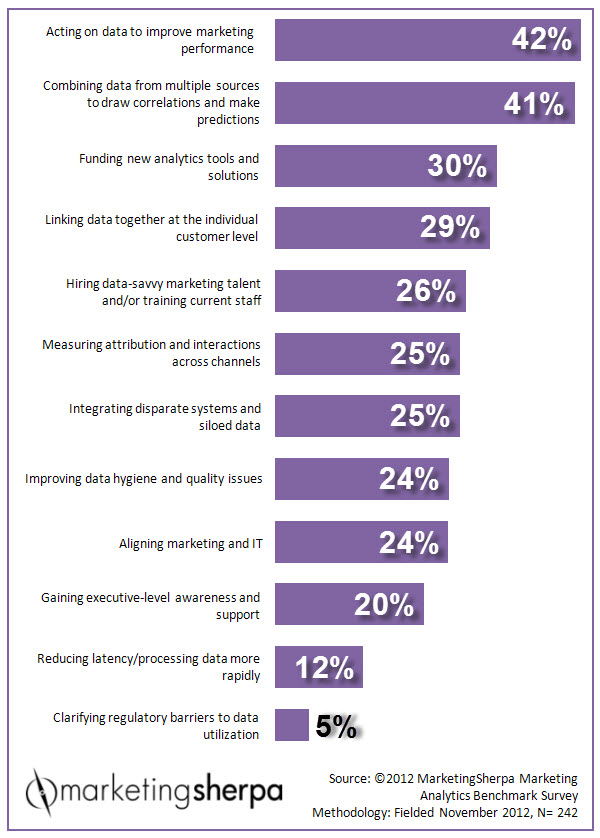Marketing Analytics: Now that marketers can collect data, interpretation is the top challenge
Technology is fantastic. But, it’s not magic.
Marketing analytics can be extremely powerful. However, just like any other tool or technology, it takes hard (and smart) work to turn data into knowledge.
So, in the MarketingSherpa 2013 Marketing Analytics Benchmark Report (sponsored by Paramore), we asked marketers …
Q: What were your organization’s most frustrating challenges with marketing analytics in 2012?
Then, we asked your peers what they thought about this marketing research. Here’s what they had to say …
Interpretation of data
What is interesting is that the top two challenges are related to the interpretation of data, not the collection of data.
We have finally turned the corner on the basic blocking and tackling of data consolidation through technology and processes, and now the most important challenges are focused on how to effectively use the analytics for improved decision making.
It has taken a long time to get to this point, but it is encouraging to see that 42% of respondents stated that acting on data to improve marketing performance was their #1 challenge, followed by combining data from multiple sources to draw correlations and make predictions (41%).
Integrating systems and siloed data finally has fallen to the bottom as most marketers have the technology and tools to do this process. Now we have to do the hard part and make the data talk to us, guide us, and give us insights.
– Cyndi Greenglass, Senior Vice President, Strategic Solutions, Diamond Marketing Solutions
Spending never makes sense, investments do
As the mantra goes, “clarity trumps persuasion.” Perhaps it is a matter of trying to make sense of the data rather than persuading C-level to spend more on online marketing. Spending never makes sense. Investments do.
A few clients come to mind where the case wasn’t [a] low marketing budget, but poor analysis of the data and money got spent by inertia, instead of being focused on campaigns that make the strongest bang for the buck. It took a C-level lingo to help the managers see the need of going through the data and extracting actionable advice.
Let the data speak, translate it into “C-lingo” and the rest should be easy.
In another instance, where the client was a local business, it took quoting serious sources and explaining why content marketing as pull marketing activity is a lot better than PPC, where the landing page is a product page (push marketing).
In both cases, it took C-level talking to help managers understand analytics data and point out the steps needed, which made great ROI sense.
With the first client, they had a clear understanding of what needs to be done to fix a very bad SEO situation.
The second client managed to cut PPC spending by 28%, reinvest in content marketing and within a year, end up with about 70% more leads for the same marketing budget.
Data makes sense. It’s up to analysts to make spreadsheets speak the ROI lingo, and a great team to follow up on the to-do list.
– Igor Mateski, Owner, WebMaxFormance
Related Resources:
Marketing Analytics: Managing through measurement and marketing as revenue center
Download Your Free Excerpt from the MarketingSherpa 2013 Marketing Analytics Benchmark Report
Marketing Metrics: Do your analytics capture the real reasons customers buy from you?
The Top 3 Online Activities That Will Get Your Business Growing Again (via WebMaxFormance)
Using Online Competition Analysis In Search-Powered Economy (via WebMaxFormance)
Getting to Know Your Audience = Testing (via Paramore)
Categories: Marketing analytics, data interpretation, marketing analytics, test interpretation, testing











Aligning marketing and IT… this one is harder than I imagined.
We are working with a client right now trying to achieve this.
They have loads of data but it’s essentially just sat there for 4 years.
Great post as always